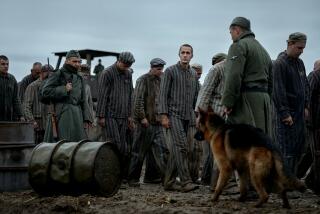Gritty, stark looks at World War II
- Share via
Documentary filmmakers chronicling the Iraq war, including Rory Kennedy (“Ghosts of Abu Ghraib”) and Terry Sanders (“Fighting for Life”), have not shied away from showing the nightmarish horrors of the conflict. By contrast, World War II documentarians found a lot of their material suppressed.
“There was much closer regulation and control,” says Charles Wolfe, professor of film and media studies at UC Santa Barbara.
The footage generated during the war was all processed by higher authorities. “Nothing was released that had not been approved by multiple levels of the chain of command,” he says. “There was an enormous amount of material shot that was left unseen. It’s not that way now.”
So, the majority of documentaries made for the armed forces or general release were more propaganda films to rally the troops and the country. Then John Huston entered the picture. And war documentaries grew up.
Huston, the Oscar-winning writer-director of such classics as “The Maltese Falcon” and “The Treasure of the Sierra Madre,” ran into problems with the military over two of his war documentaries: 1944’s “The Battle of San Pietro” and 1946’s “Let There Be Light,” which was banned until 1980.
On Tuesday evening, the Academy of Motion Picture Arts and Sciences’ John Huston Lecture on Documentary Film at the Linwood Dunn Theater will spotlight these two documentary classics. Huston’s son Tony will be introducing the films.
Daughter Anjelica Huston, who had a scheduling conflict and can’t attend the program, recalls a famous quote of her father’s after a general told him the original cut of “San Pietro” was too antiwar. “Well, sir,” said John Huston, “whenever I make a film that’s for war, you can take me out and shoot me.”
Huston began shooting documentaries in 1942 as a member of the U.S. Army Signal Corps unit that was headed by director Frank Capra. His first film, “Report From the Aleutians,” won approval of the military authorities.
But that wasn’t the case initially with “San Pietro,” a gritty, stark look at a 1943 battle between U.S. forces and Germans at the 700-year-old town in Italy’s Liri River Valley. Some 1,100 Americans died.
“Granted, he had film crews and directors of photography, but the documentaries dictated he be there,” says Huston. “The idea that he had not only been in these situations and survived and had lived to record them was something incredibly impressive to me at a terribly young age.”
Wolfe, who will be discussing the films at the academy event, says it is inaccurate to describe “San Pietro” as having been banned, though it “created a great consternation with various chains of command as to whether or not the film should be released,” he says.
“There was a lot of negotiations going on between the Signal photographic unit that Capra was heading and for whom Huston was working and authorities in Washington, D.C.,” says Wolfe. “It gets edited, changed a little bit. The film was finally released in 1945 with a great deal of fanfare. The academy is showing a longer version of the film, which is an earlier cut that Huston made of the film.”
“Let There Be Light,” an unflinching portrait of returning vets’ psychological disorders, had a harder time reaching the screen. Huston “did make sure that releases [from the patients profiled] were signed, but there were some technicalities about the releases that the War Department’s legal department was able to use to prevent the film” from being released, Wolfe says.
“Let There Be Light” was finally unveiled publicly at a major screening at the Museum of Modern Art in 1981.
“It was quite a moment,” Anjelica Huston says. “It was also a culmination [for my father] of many years of anger too. At no point was he off-balance about his intent and belief [for the film]. My father was very clear about his morality, and I think he always thought the War Department had made a huge mistake in not showing these films.”
--
--
‘John Huston’s Suppressed World War II Documentaries’
Where: Linwood Dunn Theater, 1313 Vine St., Hollywood
When: 7:30 p.m. Tuesday
Price: $5
Information: (310) 247-3600
More to Read
Only good movies
Get the Indie Focus newsletter, Mark Olsen's weekly guide to the world of cinema.
You may occasionally receive promotional content from the Los Angeles Times.











